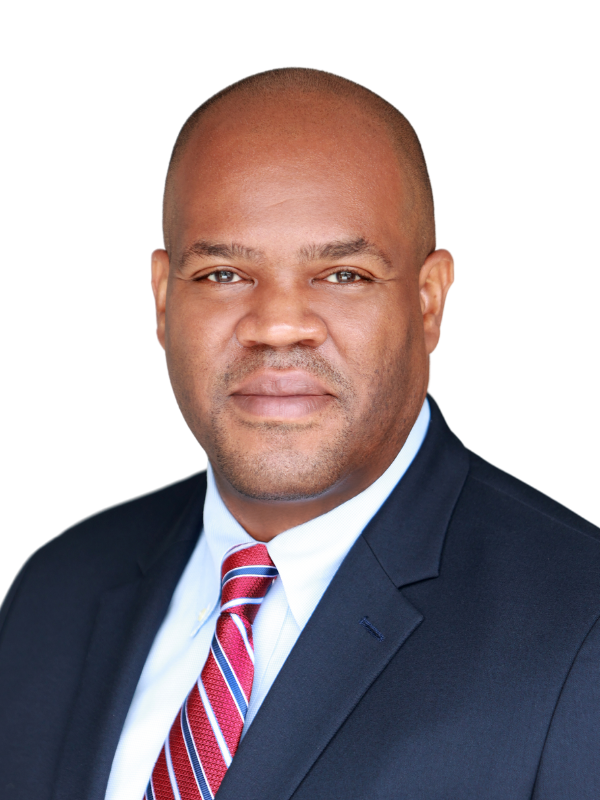
Engaging Stakeholders Early: Lessons from Public Sector Planning that Improve Justice Facility Outcomes
We Have Far More in Common Than You Think
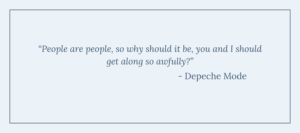
There are three key reasons why I chose to open this post with that quote: 1) The song was released one day before my 10th birthday; 2) I hoped it would grab your attention and spark curiosity about the connection between the lyric, stakeholders, and this post; 3) It played a significant role in shaping the way I approach meeting and interacting with people. “People are people” may seem to be a simple concept, yet it’s often overlooked due to distinctions we place on one another – whether based on perceived socio-economic status, race, gender or gender identity, nationality, ethnicity, age, perceived political affiliation, or cultural background.
When you really think about it – how different are we, as humans, from one another? Around the world, people wake up, get dressed, eat, either go to school or work, return home, share a meal, relax, sleep and repeat a routine that is distinctly human. For seven years, I lived and worked in three different countries (Romania, Saudi Arabia, and Japan) and can speak to this from experience as I believe this mindset is crucial when engaging individuals – it is a reminder that, despite our differences, we share far more in common. It is this shared humanity which can help us engage in meaningful conversations.
A stakeholder is defined as “one who is involved or affected by a course of action.” In the realm of community projects, stakeholders are not just passive observers but active participants whose insights and influence can significantly shape project outcomes. Their early engagement is essential, as stakeholder involvement not only increases the likelihood of project acceptance but also strengthens its overall effectiveness and sustainability within a given community.
The Power of Stakeholder Perspective
Stakeholders provide project leaders with diverse perspectives, offering invaluable input on a wide range of critical aspects of their community. They can identify potential social, economic, and environmental challenges that might otherwise go unnoticed, helping to mitigate risks before they become obstacles. Their local knowledge and lived experiences can highlight small yet meaningful adjustments that enhance the project’s practicality and community impact. Furthermore, stakeholders can offer historical context that may affect how the project is perceived, ensuring that past experiences and cultural considerations are acknowledged in the planning process.
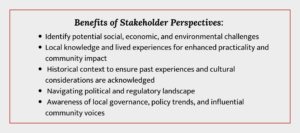
Beyond logistical and historical insights, stakeholders play a key role in navigating the political and regulatory landscape. Their awareness of local governance, policy trends, and influential community voices can help project leaders anticipate political hurdles and align their initiatives with broader municipal or regional goals.
By incorporating stakeholder feedback throughout the planning and implementation phases, project leaders can proactively address concerns, build trust, and cultivate a sense of shared ownership. This collaborative approach not only fosters goodwill but also lays the foundation for long-term community support, ultimately leading to more successful and sustainable project outcomes.
The Earlier, the Better
Early stakeholder engagement significantly improves a project’s chances of being well-received. When stakeholders see that their input has been genuinely considered, it generates goodwill, strengthens relationships, and builds trust between project leaders and the community. Ultimately, open and meaningful conversations with stakeholders are essential to extracting the information needed to make these engagements truly effective. Thoughtful dialogue not only enhances project design but also ensures that the community feels heard and valued, laying the foundation for long-term collaboration and success.
A meaningful conversation should be the goal of every interaction between individuals seeking information and those providing it. Planners actively seek specialized knowledge, including expert information and diverse opinions, to ensure that their recommendations or proposals effectively meet the needs and expectations of all interested parties. This process inherently relies on the necessity of meaningful conversations.
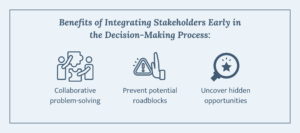
Furthermore, engagement is most effective when it is proactive rather than reactive. Waiting until challenges arise to involve stakeholders can create unnecessary friction and resistance. Instead, integrating stakeholders early in the decision-making process allows for collaborative problem-solving, preventing potential roadblocks before they escalate. This early involvement also helps uncover hidden opportunities, as local stakeholders often possess invaluable knowledge about their communities that can shape more effective and context-sensitive solutions.
Speaking from Experience
I encountered one such instance that required a significant conversation to clarify a project and ultimately gain the support of the community…
I was tasked with developing a unified zoning ordinance and subdivision regulations for a small, rural jurisdiction in Georgia. The project was initiated by the mayor, who aimed to provide much-needed land-use guidance and establish clear regulations to govern land-use activities within the community. However, not all members of the stakeholder committee were in favor of the project. One committee member was particularly opposed to the initiative and consistently attempted to hinder its progress.
I engaged in a conversation with this stakeholder, hoping to offer clarity and assist in improving his understanding of the project. During our discussion, the stakeholder openly expressed his concerns. He explained that he saw me as an outsider and felt apprehensive about my involvement in community policy creation and advisement on what was best for the needs of their jurisdiction. His primary concern was that the proposed regulations would lead to increased governmental control over private property, which he strongly opposed.
We engaged in a thoughtful and meaningful conversation in which I clarified my role in the project. I explained that my responsibility was to conduct thorough research, present best practices, and then work with the stakeholders to decide how much and which regulations, if any, were appropriate for their community. I emphasized that the decisions regarding the extent and type of regulations would ultimately be made by the stakeholders themselves, not imposed by me. While the conversation was much longer and more nuanced than what is captured here, taking the time to listen to his concerns and engage in open dialogue ultimately had a positive outcome. What began as a point of contention turned into a productive and meaningful exchange, and over time, this conversation helped transform a vocal critic into a strong participant and supporter of the project. In the end, the project was successfully adopted by the jurisdiction.
Keep It Clear and Simple
The use of meaningful conversations to engage stakeholders in the early stages of a project is absolutely crucial. Potential stakeholders, just like multiple members of the community population, may have already formed opinions about an upcoming project from (many times) unverified and wrong information. This is why it’s so important communication with potential stakeholders be simple, clear, and provide accurate information. As you read this, you may be thinking to yourself, “Sure, I already know this.” However, even when you believe you are ready, things can quickly turn against you.
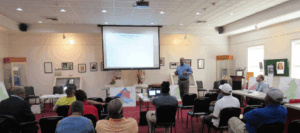
Martin Laws presents to a group of stakeholders, focusing on engaging the attendees while keeping his delivery direct and the information clear, simple, and rooted in facts.
A county in Georgia requested that I draft an amendment to their zoning ordinance to address a specific issue not covered by the existing regulations. There had been a growing interest in a particular agricultural use within the county, prompting the need for clearer guidelines. In response, I developed a proposed amendment to the zoning ordinance, along with a presentation for the County Planning Commission to provide appropriate guidance for the use. The presentation was designed to explain the proposed changes and how they could be implemented to effectively regulate this specific agricultural use.
When I arrived at the Planning Commission meeting, I was surprised to find the room completely full. Initially, I assumed the large turnout was unrelated to my presentation. However, I soon realized I was mistaken—my proposal became the “talk of the town” in the days leading up to the meeting, generating significant interest and discussion among community members.
After my presentation, I stepped to the side to allow the Planning Commission to resume their meeting. Shortly afterward, they opened the floor for questions. At that moment, it felt as if the crowd was about to pull out their pitchforks and torches. Of course, that didn’t actually happen—but the intensity of the residents’ frustration was very real. Their collective ire was directed squarely at me. I had no idea why, as I was simply providing a proposal to address an issue. I did my absolute best to address their questions and concerns related to my presentation.
However, I soon realized that many of the questions had little to do with the proposed ordinance amendment. Some residents voiced frustrations about completely unrelated zoning matters, and one particularly upset individual railed against language that had already been part of the county’s zoning ordinance for years. As tensions rose, a county commissioner finally stood up and addressed the room, calling for order and telling the residents to stop their disruptive behavior. It was then that I began to understand the real motive behind the commotion. The residents weren’t necessarily trying to derail the proposed amendment—they simply wanted to be heard.
It’s Not Just WHAT You Say, It’s HOW and WHY You Say It
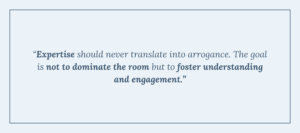
A successful presentation requires more than just knowledge of the subject matter—it demands clarity, factual accuracy, and the ability to navigate challenging interactions with professionalism. A presenter must be fully prepared to convey information effectively while also knowing when to stop speaking. However, expertise should never translate into arrogance. The goal is not to dominate the room but to foster understanding and engagement.
In a presentation, not every question or comment will be constructive. Some may seek clarification or attempt to provide information, while others may aim to antagonize or derail the discussion. In such cases, the best approach is to remain composed, acknowledge the concerns raised, and respond with clear, fact-based information. It is not always necessary to argue a point; rather, the focus should be on ensuring that the audience—especially those genuinely interested in the topic—can access and process accurate information from the presentation. When opinion-based questions arise, responses and solutions should be rooted in facts and data, maintaining credibility while steering clear of unnecessary debates.
Even the most well-prepared presenter can face disruptions from individuals or groups attempting to hijack the discussion. When this happens, staying grounded in factual correctness is the most effective strategy. While it may be tempting to engage with those causing a disturbance, it is important to remember that they are not the only ones in the room. Most attendees are there to learn; and by maintaining composure and reinforcing key points, a presenter ensures that the intended message remains accessible. Clear, consistent communication allows the audience to filter out distractions and focus on the value being offered. Ultimately, the effectiveness of a presentation is not determined by the loudest voices in the room but by the clarity and credibility of the information shared.
Consider Group Dynamics and Proceed Accordingly
I have had the opportunity to collaborate with multiple stakeholder groups composed of volunteers dedicated to enhancing their communities through initiatives that benefit their respective jurisdictions. The individuals within these groups are often driven by a strong sense of altruism and a genuine commitment to supporting projects by sharing their insights and perspectives, which are shaped by their lived experiences in their communities or geographic areas. However, group dynamics can vary significantly. Some stakeholder groups are highly inquisitive, eager to contribute vast amounts of information, while others may have valuable input but are less inclined to share unless prompted.
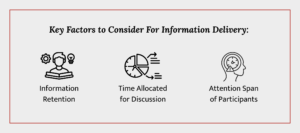
Effectively engaging stakeholders in meaningful discussions requires the facilitator to quickly assess the group’s dynamics and determine the most appropriate tools to foster productive dialogue. A key consideration is whether a PowerPoint presentation is the optimal method to stimulate discussion. While presenting new information can be beneficial, facilitators must also account for factors such as information retention, the time allocated for discussion, and the attention span of participants, many of whom are balancing these engagements with their work, family, or other responsibilities.
Tailoring Your Approach to Your Audience
A well-structured approach often involves shorter PowerPoint presentations that provide key information while allowing stakeholders to ask clarifying questions. This approach encourages participants to engage in discussion, ask relevant questions, and provide local and immediate examples that enrich the conversation. Additionally, incorporating tailored questions within the presentation can help guide the dialogue toward gathering the most valuable insights. Allowing ample time for discussion ensures that all participants have an opportunity to voice their perspectives if they choose to do so.
In some instances, directly inviting individuals to share their thoughts during a meeting can encourage participation. However, I have found that respecting different communication preferences is equally important. For those hesitant to speak in a group setting, following up with them individually after the meeting often leads to more candid and meaningful exchanges. This approach not only acknowledges their preference for one-on-one discussions but also ensures their valuable perspectives are included in the decision-making process.
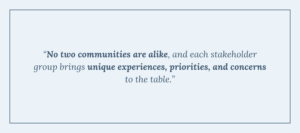
Throughout my experiences working across different communities, I have seen firsthand how adaptability, patience, and clear communication are essential when navigating diverse perspectives. No two communities are alike, and each stakeholder group brings unique experiences, priorities, and concerns to the table. Some may be eager to share their insights, while others may be more hesitant, requiring reassurance that their voices matter. Effective engagement requires not only sharing information but also actively listening, addressing concerns, and identifying areas of common ground. By fostering an environment where people feel comfortable expressing their viewpoints, we create a foundation of trust that strengthens relationships and enhances the likelihood of successful project implementation.
It Comes Down to Trust. Understanding, and Collaboration
At its core, stakeholder engagement is about more than just gathering input—it is about fostering meaningful conversations that build trust, mutual understanding, and collaboration. Engaging stakeholders is not a one-time task but an ongoing process that requires continuous dialogue, transparency, and a genuine commitment to inclusivity. Whether through structured discussions, thoughtful presentations or informal exchanges, the goal remains the same: to ensure that all voices are heard, valued, and considered. When individuals recognize that their perspectives are not only acknowledged but also play a role in shaping outcomes, they become invested in the process, transforming from passive participants to active contributors.
When stakeholders feel genuinely included in the process, they are more likely to support and champion a project, ultimately leading to stronger, more sustainable outcomes. Meaningful engagement goes beyond simply checking a box—it requires building relationships, maintaining open lines of communication, and demonstrating a commitment to shared goals. By embracing dialogue as a tool for connection and progress, we create opportunities to bridge divides, dispel misconceptions, and build communities that reflect the collective vision of those who call them home. When done correctly, stakeholder engagement not only enhances individual projects but also cultivates a culture of collaboration that extends far beyond any single initiative, fostering long-term trust and cooperation within the community.
